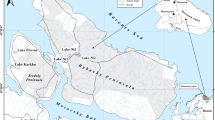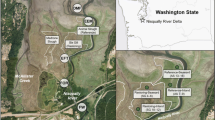Abstract
Deposition of suspended sediments andtheir associated nutrients were estimated during theflood event of 1995 in the seasonally flooded forestsof the Mapire and Caura Rivers, two black-watertributaries of lower Orinoco, and on two islands ofthis white-water river. The deposition spanned a widerange from 0.07 kg m−2 in the depositional barforests of the Mapire River to 73.60 kg m−2 onthe flooded forests of the Orinoco Island site calledJarizo. This variation is associated with the dynamicnature of sediment mobilization, transport anddeposition, as well as with the different geomorphicenvironments and erosion processes upstream from thestudy sites. The deposited sediment in all the studyareas was highly quartzitic with a relatively highcontent of kaolinite and goethite. Only in thesediment of the Orinoco Islands was mica (illite)identified in a relatively high proportion. Thesemineralogical results reflect the intense weatheringprocesses in the catchment areas of the study rivers.The chemical composition of the deposited sedimentsshowed a great variability among the different studyareas, which is in part related to the mineralcomposition of the sediments and their particle sizedistribution. The highest concentrations of K, Caand Mg were found on the clay sediments of the Orinocoagricultural island. The total amount of depositednutrients varied over a wide range, which isinfluenced by the amount of deposited sediments. Inthe Jarizo Island site of lower Orinoco were depositedthe largest amount of nutrients. In the floodedforests of the Mapire River, the nutrient contributionby the deposited sediments to the nutrient cycling isrelatively low in the depositional-bar forests andpractically nonexistent in the forests sites onterraces.
Similar content being viewed by others
References
Barrios E, Herrera R & Valles JL (1994) Tropical floodplain agroforestry system in mid-Orinoco River basin, Venezuela. Agrofor. Syst. 28: 143–157
Brinson MM, Lugo AE & Brown S (1981) Primary productivity, decomposition and consumer activity in freshwater wetlands. Ann Rev of Ecol. and Syst 12: 123–161
Busacca A, Aniku J & Singer M (1984) Dispersion of soils by an ultrasonic method that eliminates probe contact. Soil Sci. Soc. Amer. J. 48: 1125–1129
Carbón J & Schubert C (1994) Late Cenozoic history of the eastern Llanos of Venezuela: geomorphology and stratigraphy of the Mesa Formation. Quaternary International 21: 91–100
Chauvel A, Walker I & Lucas Y (1996) Sedimentation and pedogenesis in a Central Amazonian Black water basin. Biogeochemistry 33: 77–95
Cooper JR, Gilliam JW, Daniels RB & Robarge WP (1987) Riparian areas as filters for agricultural sediment. Soil Sci. Soc. Amer. J. 51: 416–420
Dawson FH (1981) The downstream transport of fine material and the organic matter balance for a section of a small chalk stream in southern England.J. Ecol. 69: 367–380
Day PR (1965) Particle fractionation and particle size analysis. In: Black CA (Ed) Methods of Soil Analysis. Part 1: Physical and Mineralogical Properties, Including Statistics of Measurement and Sampling (pp 545–567). Agronomy 9
Depetris PJ & Paolini JE (1991) Biogeochemical aspects of South American rivers: The Paraná and the Orinoco. In: Degens ET, Kempe S & Richey JE (Eds) Biogeochemistry of Major World Rivers (pp 105–125). Scope 42, John Wiley & Sons
Ewel JJ & Madríz A (1968) Zonas de Vida de Venezuela. Memoria Explicativa sobre el Mapa Ecológico (p 264).
Ministerio de Agricultura y Cría, Dirección de Investigaciones, Caracas Forsberg C (1989) Importance of sediments in understanding nutrient cyclings in lakes. Hydrobiologia 176/177: 263–277
Froelich PN (1988) Kinetic control of dissolved phosphate in natural rivers and estuaries: A primer on the phosphate buffer mechanism. Limnology and Oceanography 33: 649–668
Furch K (1997) Chemistry of Várzea and Igapó Soils and Nutrient Inventory of their Floodplain Forest. In: Junk WJ (Ed) The Central Amazon Floodplain. Ecology of a Pulsing System (pp 47–67). Ecological Studies 126 Springer-Verlag, Berlin.
García S (1996) Limnología. In: Rosales J & Huber O (Eds) Ecología de la Cuenca del Río Caura, Venezuela. I. Caracterización general (pp 54–59). Scientia Guaianae 6
Genrich D & Bremner J (1972) A reevaluation of the ultrasonic vibration method of dispersing soils. Soil Sci. Soc. Amer. Proc. 36: 944–947
He Q & Walling DE (1997) Spatial variability of the particle size composition of overbank floodplain deposits. Water, Air and Soil Pollution 99: 71–80
Howard-Williams C (1985) Cycling and retention of nitrogen and phosphorus in wetlands: a theoretical and applied perspective. Freshwater Biol. 15: 391–431
Irion G, Junk WJ & J de Mello (1997) The large Central Amazonian River floodplains near Manaus: Geological, climatological, hydrological and geomorphological aspects. In: Junk WJ (Ed) The Central Amazon Floodplain. Ecology of a Pulsing System (pp 23–46). Ecological Studies 126 Springer-Verlag, Berlin
Jackson ML (1976) Análisis químico de suelos (3rd edn). Editorial Omega, Barcelona
Junk WJ (1997) General aspects of floodplain ecology with special reference to Amazonian floodplains. In: Junk WJ (Ed) The Central Amazon Floodplain. Ecology of a Pulsing System (pp 3–20). Ecological Studies 126 Springer-Verlag, Berlin
Junk WJ, Bayley PB & Sparks RE (1989) The flood pulse concept in river-floodplain systems. In: Dodge DP (Ed) Proc. International Large River Symposium. Can. Spec. Publ. Fish Aquat. Sci. 106: 110–127
Junk WJ & Welcomme RL (1990) Floodplains. In: Patten BC, Jorgensen SE & Dumon H (Eds) Wetlands and Shallow Continental Water Bodies 1 (pp 491–524). SPB Acad Publ bv, The Hague, The Netherlands
Kalliola R, Linna A, Puhakka M, Salo J & Räsänen M (1993) Mineral nutrient in fluvial sediments from the Peruvian Amazon. Catena 20: 333–349
Lewis WM Jr, Saunders JF, Levine SN & Weibezahn FH (1986) Organic carbon in the Caura River, Venezuela. Limnol Oceanogr 31: 653–656
Lowrance RR, Todd RL & Asmussen LE (1984) Nutrient Cycling in an Agricultural Watershed: II. Streamflow and Artificial Drainage. J. Environ. Qual. 13: 22–32
McLean EO (1965) Aluminium. In: Black CA (Ed) Methods of Soil Analysis. Part 2 (pp 985–994). Agronomy 9
Martínez M (1996) Clima: gradientes bioclimáticos. In: Rosales J & Huber O (Eds) Ecología de la Cuenca del Río Caura, Venezuela. I. Caracterización general (pp 40–43). Scientia Guaianae 6
Meade RH, Weibezahn FH, Lewis WM Jr & Pérez-Hernández D (1990) Suspended-sediment budget for the Orinoco River. In: Weibezahn FH, Alvarez H & Lewis WM Jr (Eds) The Orinoco River as an Ecosystem (pp 55–79). Impresos Rubel CA. Caracas
Mertes LAK (1994) Rates of flood-plain sedimentation on the Central Amazon River. Geology 22: 171–174
Murphy J & Riley JP (1962) A modified single solution method for the determination of phosphate in a natural waters. Analytical Chemistry Acta 27: 31–36
Németh A, Paolini J & Herrera R (1982) Carbon Transport in the Orinoco River: Preliminary Results. In: Degens ET (Ed) Transport of Carbon and Minerals in Major World Rivers. Part 1 (pp 357–364). Mitt Geol Paläont Inst Univ Hamburg Heft 52
Nelson WL, Mehlich A & Winters E (1953) The development, evaluation and use of soil test for phosphorus availability. Agronomy 4: 153–188
Parfitt RL (1989) Phosphate reactions with natural allophane, ferrihydrite and goethite. J. Soil Sci. 40: 359–369
Pinay G, Ruffinoni C & Fabre A (1995) Nitrogen cycling in two riparian forest soils under different geomorphic conditions. Biogeochemistry 30: 9–29
Rosales J (1989) Análisis florístico-estructural y algunas relaciones ecológicas en un bosque inundable en la boca del Río Mapire (Estado Anzoátegui) (p 233). MSc Thesis, Instituto Venezolano de Investigaciones Científicas, Caracas
Rosales J (1996) Vegetación: los bosques ribereños. In: Rosales J & Huber O (Eds) Ecología de la Cuenca del Río Caura, Venezuela. I. Caracterización general (pp 66–75). Scientia Guaianae 6
Schwertmman U & Taylor R (1977) Iron oxides. In: Dixon J & Weed S (Eds) Minerals in Soil environments (pp 145–176). SSSA Book Ser., Madison WI
Stallard RF, Koehnken L & Johnson MJ (1990) Weathering processes and the composition of inorganic material transported through the Orinoco River. In: Weibezahn FH, Alvarez H & Lewis WM Jr (Eds) The Orinoco River as an Ecosystem (pp 81–119). Impresos Rubel CA, Caracas
Thomas GW (1982) Exchangeable cations. In: Page AL, Miller RH & Keeny DR (Eds) Methods of Soil AnalysisPart 2 (pp 159–166). Agronomy 9
Vargas H & Rangel J (1996) Hidrología y sedimentos. In: Rosales J & Huber O (Eds) Ecología de la Cuenca del Río Caura, Venezuela. I. Caracterización general (pp 48–53). Scientia Guaianae 6
Vegas-VilarrÚbia T (1988) Aproximación a una clasificación de los ríos de aguas negras venezolanos atendiendo a las características de sus sustancias hÚmicas y variables físicoquímicas (p 135). MSc Thesis, Instituto Venezolano de Investigaciones Científicas, Caracas
Vegas-VilarrÚbia T & Herrera R (1993) Effects of periodic flooding on the water chemistry and primary production of the Mapire systems (Venezuela). Hydrobiologia 262: 31–42
Walling DE & He Q (1997) Use of fallout 137Cs in investigations of overbank sediment deposition on river floodplains. Catena 29: 263–282
Whittig L (1965) X-ray diffraction techniques for mineral identification and mineralogical composition. In: Black CA (Ed) Methods of Soil Analysis. Part 1: Physical and Mineralogical Properties, Including Statistics of Measurement and Sampling (pp 671–698). Agronomy 9
Whittig L & Allardice W (1986) X-ray diffraction techniques. In: Klute A (Ed) Methods of Soil Analysis. Part 1: Physical and Mineralogical Methods (pp 331–362). Agronomy 9
Author information
Authors and Affiliations
Rights and permissions
About this article
Cite this article
Dezzeo, N., Herrera, R., Escalante, G. et al. Deposition of sediments during a flood event on seasonally flooded forests of the lower Orinoco River and two of its black-water tributaries, Venezuela. Biogeochemistry 49, 241–257 (2000). https://doi.org/10.1023/A:1006375101368
Issue Date:
DOI: https://doi.org/10.1023/A:1006375101368




